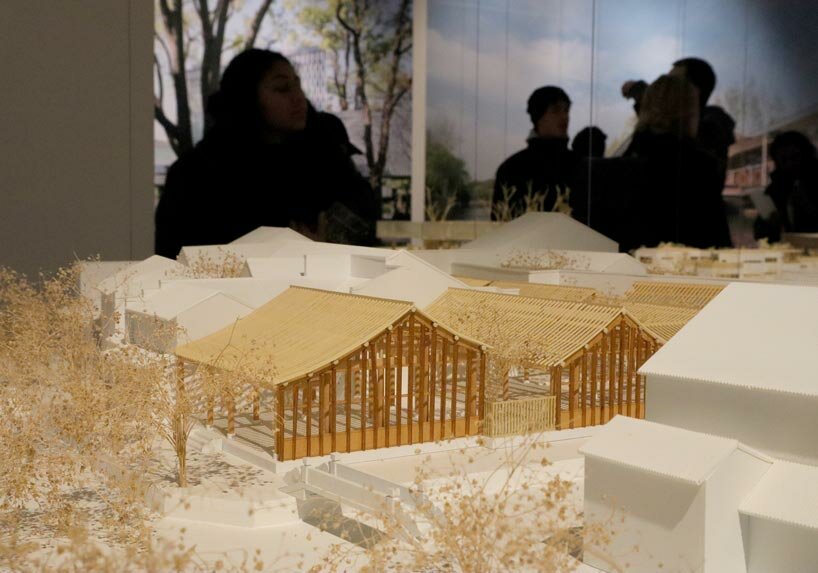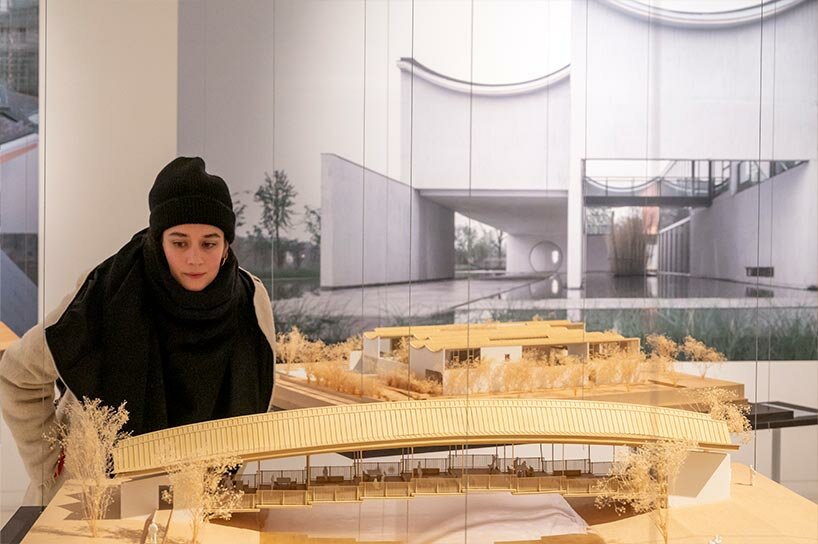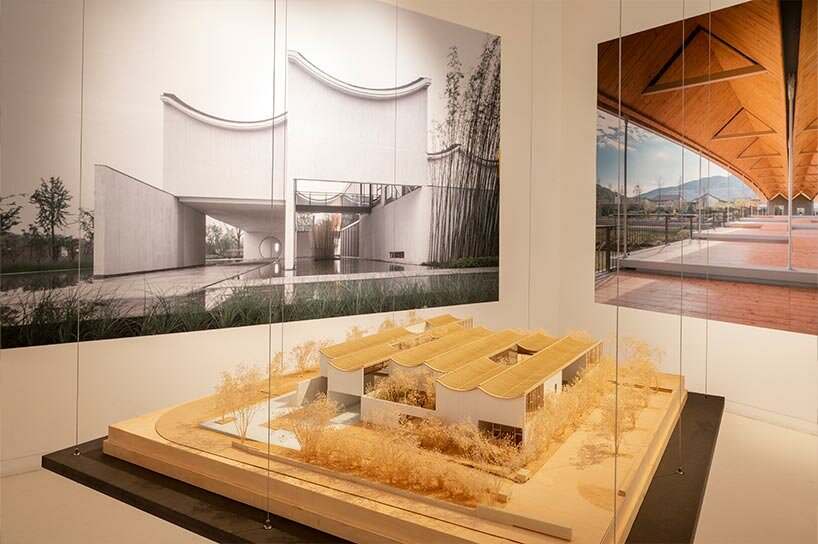[ad_1]
scenic architecture opens Translated Traditions at aedes
Scenic Architecture Office celebrates the opening of ‘Translated Traditions – Public Courtyards and Urban Platforms,’ with its current exhibition at Aedes Architecture Forum in Berlin. On view now until January 25th, 2023, the show brings together nine programmatically very divergent projects, spotlighting the practice’s large body of work and design approach. designboom attended the opening at Aedes, and interviewed Zhu Xiaofeng, architect and founder of the Shanghai-based office, to talk about what informs its design process, and how the traditions can meet today’s demands and future expectations. (See the interview below)
Created in recent years in the Jiangnan region around the city of Shanghai — a site known for its humid subtropical summer and cool winter — the projects seamlessly blend into their urban or landscape setting, generating spaces that are functional and pleasant to experience even in severe climate conditions. The structures, ranging from rowing clubs and kindergartens to art galleries and cultural centers, are characterized by their generous public spaces in the form of inner courtyards or vertically layered platforms, while expressive roof arrangements foster versatile spatial concepts with staggered open levels that create airy and shaded gathering spaces. Usually extending horizontally, the architecture can be used all year round, despite the weather, informed by memories of the past and tradition and technically adjusted to meet today’s requirements.

Shengli Street Neighborhood Committee and Senior Citizens’ Daycare Center, Shanghai | image and header video © designboom
interviewing scenic architecture
designboom: ‘Translated Traditions – Public Courtyards and Urban Platforms’ is the title of the exhibition we will have the joy of attending afterward. Can you elaborate on this a bit more?
Zhu Xiaofeng: What I always believed is that the past, the present, and the future is a continuous evolution. As the process continues, it’s essential for us to respect the past while we are trying to move forward to the future. Confronting contemporary challenges of environmental crisis, our traditions, including philosophical concepts and typology of space or tectonic, e.g., courtyard, platform, or roof system, can remind us to reflect on our technical rationality, enlighten us to improve our vision of sustainability, and inspire us to combine them with modern technology and contemporary life, to explore a new architecture.
DB: You have been offering architectural solutions for over 20 years – since the studio was founded. How has your studio evolved over this course?
ZX: We’ve constantly been examining how to use architecture as a vessel to explore a balanced and dynamic relationship between human environments and technology. This is something we never changed. But in terms of evolution, we do have some different eras in the past 20 years. From 2004, after I returned from the States to Shanghai, to 2011, I have worked more with context. I was amazed by the context I got, environmental and cultural. We worked with contexts at the urban scale, urban traditions, and contemporary urban realities. From 2012 to 2018, I was more interested in structural space, such as tectonic issues. I like the systematic approach, which is probably evident in our exhibition. Our team always uses a systematic methodology to create a new architecture, which can give people experiments of a new world or new, small cosmos. In the recent five years, we have worked more with typology. The more we work, the more practice we get, finding interest in reintroducing traditions, including traditional typology found either spatial, like the courtyard life, or even tectonic issues of a pitched roof heritage. So this is something that gives us freshness, and in combination with contemporary technologies, we seek to make new buildings.

Bridge of Nine Terraces, Nanjing Scenic Architecture Office | image ©Erik-Jan Ouwerkerk
DB: Is there a philosophy that your practice is faithfully committed to?
ZX: I don’t think there was a philosophy in the beginning, I was just trying to make good architecture.
In recent years we have come up with some kind of philosophical concepts for our practice. We use three paths of architectural evolution: These are Body & Mind, Ontology, and Interaction. Body & Mind is the origin of architecture, all kinds of human-made things are created by the body and mind, including architecture. This should be how architecture gets started and how you think about it. It’s still very important for us, maybe until robots take over our bodies.
As for the second term: when architecture established itself, it started to have its own principles and logic. That is what I call ontology, including either spatial-wise or tectonic-wise. This is the autonomy of architecture. And the third path is interaction. Architecture can never get evolved without interactions with other elements and systems — artificial, natural, and social. In the past 10 or 20 years, technology took over this interaction again, just like 100 years ago, right after the industrial revolution, pushing architecture forward. In the second half of the 20th century, it might not have been technology; instead, it was maybe intellectual thoughts about architecture. So, I use this model to testify our works and try always to ask myself, how can I see the Body & Mind there; have I engaged deeply with the ontological architecture elements, and what are the interactions I had to push this new methodology over new projects? Behind these three terms, the basic philosophy of how to see these elements as equivalent or balanced grounds is Daoism from Chinese culture. This way of life sees humans and nature as one unification. Daoism respects nature and humans as equivalent; they coexist harmoniously. We have always trusted this kind of philosophy and to this day, we follow it faithfully.

Dongyuan Qianxun Community Center, Suzhou | image ©Erik-Jan Ouwerkerk
DB: What are the biggest challenges you face when tradition meets today’s demands and/or future expectations?
ZX: We see tradition as an extraction of our past. We shall not see architectural tradition just as outdated history, it rather carries the wisdom of previous facts we shall respect, and bring them up to our future. The first challenge is on the level of methodology: how to find the bonding point between traditions and contemporaneity. Sometimes conflicts are revealed between literal references from tradition and those from contemporary life. Here the challenge is to find ways to make it more conceptual or ideological, giving solutions to this problem. The second challenge is the attitude of how you see tradition and its value. Sometimes it’s an arbitrary cutoff or separation from tradition; you need an impartial and innovative attitude to bind old and new.
DB: How do you see the traditional role of the architect changing, considering current issues such as climate change and sustainability?
ZX: In the contemporary world, the role of architects is becoming weak in a way. On the surface, it seems we’re doing more work, but it’s more of a passive era for architects. People are expecting too much from architecture, just giving too much load that architects cannot stand. We need to take a breath and make a break. But on the other hand, it is true that this passiveness is something that can guide us to even worse situations. So let’s try to be more positive, more dynamic, and even take more initiative.
Architecture is one of the principles that is a composite of a lot of disciplines. Nowadays, so many disciplines are becoming more and more fragmented. So architects need to become initiative generators and be conscious of leading fresh concepts and crossing boundaries. Meanwhile, technology can offer the opportunity for different groups of people to work together and draw inspiration from each other.
[ad_2]
Source link
